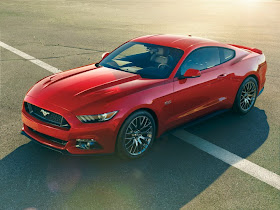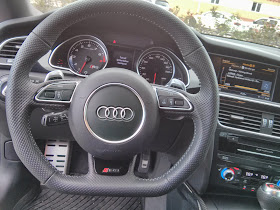 |
| Spark plugs, ignition coils and intake port gaskets ready to go! |
My back still hurts.
Sorta.
What was supposed to have been a 3 hour repair job, turned into 8 hours of wrenching. All to save a few hundred dollars in repair costs. See, some 10,000-20,000 miles ago, my Mazda 6 started experiencing *ahem* cough symptoms. No not literally coughing, more like stuttering. I noticed that whenever I tried to go full throttle at low rpm (usually below 2000), the car would start hesitating, as if trying to clear its throat while slowly pulling away. For example, the car is loafing along at a steady 65 mph with the cruise control engaged. If I decide to add 5 mph to that cruise setting without downshifting (and by pressing the ACCEL button on the cruise control area) the car would commence subtly bucking, stuttering and wheezing all the way to 70 mph before settling down again. It's a totally unnerving to experience. Every. Time.
After browsing numerous forums, YouTube channels and talking with mechanics, three diagnoses were possible: 1) fouled spark plugs/ignition coils 2) vacuum leak 3) clogged fuel injectors. I ruled out the fuel injectors pretty early, deeming that a serious case since the car has downed its fair share of fuel injector cleaners since being bought (FYI: the fuel you purchase already has additives to keep fuel injectors clean). Next item was to check for a vacuum leak. Feeling around the different hoses, listening for the distinctive hiss of escaping air turned up nothing. So considering the car's age and that the spark plugs/coils had never been replaced I zeroed in on that being the cause. Some forums mentioned a possible oil leak that might enter the spark plug chambers, thereby inhibiting the ability of a spark to be created and causing a cylinder to misfire. With that, my project was set. Here's how it went down.
 |
| Engine Cover, gotta remove this first. |
Opening up the engine bay, I'm faced with an engine cover. Take that off (held down by three nuts) and the engine block itself becomes visible. The front three spark plugs are right there (in your face) and after loosening up some electrical connectors are quite easy to replace. But wait you ask, where are the other three? Well, they're buried under the plenum/throttle body assembly towards the rear of the engine bay against the firewall. To get to those three involves first removing the battery and airbox. Why? So the multiple hoses and electrical connectors can be removed BEFORE you can even think about removing the plenum and its eight bolts. This, my friends, is where the fun begins.
 |
| With the cover off, the forward bank of spark plugs/ignition coils are exposed at the bottom of the picture, just right of the oil dip stick. |
 |
| Airbox and battery removed, the throttle body is visible (cloth underneath throttle body is catch any coolant from disconnecting the hoses. |
A total of 6 hoses (2 coolant and 4 vacuum I believe) are attached to the plastic plenum. Most were a breeze but two of the hoses were located underneath the plenum in an awkward area that was difficult to reach. To make matters worse, while I was able to remove the metal clamp that holds the hose on the fitting, the hose itself remained fused to the fitting. It took me over an hour, using a flathead screwdriver, to reach under the plenum and slowly pry the stuck hose loose before finally pulling it off. My brother, bless his heart, took care of the other hose (by this time my arms were like wet noodles). With the final hoses off and the eight bolts fastening the plenum to the block loosened, we were able to slowly and carefully remove the plenum, taking care not to bend or hit the EGR valve that inserts itself just behind the throttle body. This reveals the six intake ports along the middle of the block where "vee" in V6 comes in. Immediately, the ports were stuffed with paper towels to prevent any debris falling down them. The three rear plugs were finally visible and were replaced, one after the other, and were fitted with new ignition coils.
 |
| A better view of the ignition coils. (Instead of having a distributor and ignition wires, each spark plug has its own dedicated plug-on ignition coil) |
 |
| Two of the hoses that had to be disconnected from the plenum (they put up a fight)... |
 |
| ...so did this coolant hose. Notice the metal clip is off but the hose itself looks fused to the fitting. Prying with a flathead screwdriver eventually fixed this. |
Let's back up a bit. Remember that shuddering, stuttering noise the engine made when accelerating below 2000 rpm? While inspecting the front bank of spark plugs, I found the culprit: oil. As you can see in the image, oil not only coated the entire lower half of the middle spark plug, but got past the seal and made its way up the ignition coil itself. This, I reckon, caused the cylinder to misfire, temporarily confusing the engine's ECM and causing the engine itself to hesitate. Where did the oil leak originate? My best educated (read: layman) guess is that the valve cover gasket (the rubber seal that keeps the engine's oil within the block, around each piston and prevents it from leaking into the spark plug chambers) was bad. Which means if I was going to permanently fix this, I was going to have to further disassemble the engine, something I had neither the parts, time (or strength) for. Not only was oil found in the middle spark plug hole, but to a lesser extent on the forward right plug as well. The best course of action at this point was just to take an old (CLEAN and LINT FREE) cloth, wrap it around the extension of my socket wrench and stick it down each hole, trying to mop up as much oil as I could. Having satisfied myself that the holes were mostly clean, only then did I install the new plugs and coils. Luckily, the rear bank of plugs showed no signs of the oil leak (whew).
 |
| This is the middle, forward spark plug. Notice the amount of oil and it's up to the socket fitting. |
 |
| This is the middle spark plug hole. This was the worst of the six. |
 |
| The three old plugs. The middle by far was the worst. |
 |
| With the plenum off, the intake ports are visible (stuffed with paper towels to prevent anything falling in them) |
 |
| The rear bank of spark plugs/ignition coils are now visible. |
 |
| The lower three spark plugs came from the rear bank, they're in far better condition but I changed them anyway. |
While the engine was partially disassembled, I took the opportunity to do an old-fashioned tuneup. This involved cleaning the throttle body, cleaning the MAF sensor, changing the intake port gaskets, cleaning the EGR valve and basically topping off all the fluids.
 |
| Cleaned the crud off the EGR valve |
 |
| Replaced the intake port gaskets (old ones are green)... |
 |
| ...and cleaned the throttle body. |
Then came the process of putting everything back together, which you could imagine, was a lot easier. The trick is, just as in the beginning, taking things slowly. I sorta didn't and in my haste, I managed to misplace a small vacuum hose. Thinking it was unnecessary, I fired up the engine which in turn, voiced its disapproval of the unfinished repair by surging to 1500 rpm for a few seconds before allowing the revs to fall below 600 rpm (just above stall). It would repeat this action until I shut it off and spent the next few minutes trying to locate the errant hose. My brother's fresher arms eventually located and placed it back on it's fitting before I tried again. Everything seemed fine until we noticed a small coolant leak underneath the engine. A quick check of all the hoses we had taken off turned up nothing leaking there, so we assumed a bit of coolant had leaked out of the hoses while they were off (possibly while topping off the reservoir). We performed a bench and then a road test and checked again afterwards and the leak seemed to have stopped. See the video below for the results.
All in all it was a good day. People look at me a bit crazy when I tell them I work on my own car. For myself, it's more gratifying to know you've accomplished something that the majority of the population would rather pay someone else to do. But it's also a win if you save on the labor costs involved. Had I just given the STEED to mechanic, the labor cost would've far exceeded the cost in parts. Unless I'm diving deeper into the engine (eg. changing a timing belt or porting cylinders), I'd rather read forums (Google is your best friend here), look up how-to videos and read manuals on how its done. In many cases, your car's owners manual (that thick book taking up space in your glove compartment) has a wealth of information on your specific car's operation. It not only helps when you want to do stuff yourself, but it also informs on what your car needs so you don't get swindled by the a predatory mechanic. Believe me, it pays dividends to have even a basic knowledge of your car's inner workings. If your car happens to run on just four cylinders, your job will be that much simpler.
A few dozen Tylenol pills later and my back and knees feel better. As of this writing, the STEED still feels fantastic. Will I be doing again? Not before I've had a chance to tackle the valve cover gasket. That, for now, is another Saturday in the making.
My eternal thanks to my bro Roger who stepped in when my back and arms cried uncle.
FOOTNOTE: MY (Model Year) 2003-2007 V6 equipped Mazda 6 cars are a pain to work on. The majority of markets where the car was sold offered powertrains no bigger than the 2.3L 4 cylinder. As a result, North America's version offered a Ford Duratec 3.0L V6 that barely fit in the engine bay. This, my friends, led to a host of ungodly body contortions in order to reach, pull and disconnect the various hoses, bolts and nuts that held everything in place. If you're mechanically inclined, working on any engine is a relative breeze. However, if you're a layman like myself with more enthusiasm than skill, give yourself time and patience. A second pair of eyes and hands always helps. Always check with a certified mechanic before doing any job on your vehicle, and remember, the Internet has a wealth of information.





















































